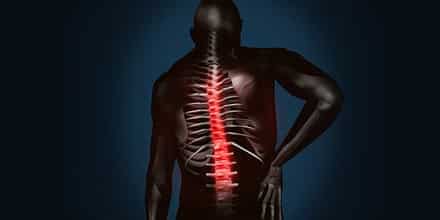Profile, Diagnosis & Treatment for Spondylolysis &Â Spondylolisthesis
Spondylolysis is a condition in which the there is a defect in a portion of a vertebrae called the pars interarticularis (a small segment of bone joining the facet joints in the back of the spine). With the condition of spondylolisthesis, the pars interarticularis defect can be on one side of the vertebrae (unilateral) or on both sides (bilaterally). The most common level it is found is at L5/S1, although spondylolisthesis can and do occur at L4/L5, but rarely at higher levels.
Spondylolysis is the most common cause of isthmic spondylolisthesis, a condition in which one vertebral body is slipped forward over another. Isthmic spondylolisthesis is the most common cause of back pain in adolescents; however, most adolescents with spondylolisthesis do not actually experience any symptoms or pain. Cases of either neurological deficits or paralysis are exceedingly rare, and for the most part it is not a dangerous condition. The most common symptom is back and/or leg pain that limits a patient’s activity level.
Since spondylolysis is the most common cause of spondylolisthesis, it may be referred to as an isthmic spondylolisthesis and sometimes these terms are used interchangeably, although this is not correct. There are at least 6 recognized causes of slippage as seen in spondylolisthesis in the literature. These causes are listed as:
- Dysplastic spondylolisthesis (which includes congenital)
- Isthmic spondylolisthesis (which includes lytic or stress fracture, an elongated but intact pars or an acute fracture of the pars)
- Degenerative spondylolisthesis (Pseudospondylolisthesis) — secondary to long-standing degenerative arthrosis (degenerative disc disease and degeneration of the facet joints)
- Traumatic spondylolisthesis (secondary to a fracture of the neural arch)
- Pathologic spondylolisthesis (from bone disease such as metastatic disease, tumor, osteoporosis, etc.)
Importantly, spondylolysis only refers to the separation of the pars interarticularis (a small bony arch of the vertebra between the facet joints), whereas spondylolisthesis refers to anterior slippage of one vertebra over another (in the front of the spine). Therefore, although the terms are sometimes used interchangeably, this is incorrect and the two are technically not interchangeable.
The underlying cause of spondylolysis has not been firmly established although its root cause is basically mechanical. According to major researchers in spine medicine there have been no recorded cases of spondylolisthesis in a new born and, therefore, the condition is not believed to be genetic. Some physicians believe that repetitive trauma (i.e., mechanical injury such as from certain sports) may either cause or contribute to the development of spondylolysis.
Activity Restrictions with Spondylolysis or Isthmic Spondylolisthesis
In the past, patients were often advised to limit their activities (especially participation in sports and active exercise) to avoid causing progression of the spondylolysis. However, new information developed from modern imaging tests and recent research indicates that reduced activity and/or rest to protect the spondylolysis from slipping may not always be necessary. Rest is only necessary if the patient becomes symptomatic. Rest can help eliminate the pain, and when the pain resolves the patient can resume his or her normal activities.
Often adolescents are pulled from their sports participation because of fears that their spondylolysis will lead to spondylolisthesis (slippage of the affected vertebra) and that the slippage will become so severe as to cause permanent damage or paralysis. Adults with spondylolysis are also often counseled to avoid rigorous exercise and/or physically demanding jobs. However, in published medical literature, there are no instances of a patient in a work, industrial, or sports-related environment that has experienced trauma causing spondylolisthesis to slip further and produce neurological deficit or paralysis.
Sophisticated imaging modalities such as single-photon emission computed tomography (SPECT) bone scans and magnetic resonance imaging (MRI) scans of the spine now provide the ability to evaluate the physiological changes that are associated with spondylolysis. This information allows for the important distinction between active and inactive spondylolysis.
- Active spondylolysis. On the SPECT scan an active spondylolysis shows uptake and an MRI scan shows bone marrow edema adjacent to the pars defect. These findings indicate that there is activity/movement associated with the pars defect, which is likely to produce symptoms of lower back pain.
- Inactive spondylolysis. If there are no indications of activity with the pars defect, then the spondylolysis is considered inactive and any low back pain the patient is experiencing is probably incidental (meaning that there is probably another cause of the patient’s lower back pain, such as a muscle strain).
Even though activity restriction is not always necessary, careful management of spondylolysis is always advisable. Acute (active) spondylolysis requires more intensive management, while symptoms from spondylolysis that has moved into a chronic (inactive) phase can be managed conservatively.
Profile and Diagnosis of Spondylolysis
Spondylolysis develops most commonly in adolescents, most typically in 10 to 15 year olds. The majority of adolescents with spondylolysis do not have symptoms, or their symptoms are mild or often overlooked. If the spondylolysis is not correctly identified and managed, there is a chance that the affected area may heal incorrectly, resulting in the possibility of continued stress that can lead to the slippage of spondylolisthesis and recurrent low back pain.
Spondylolysis is seen more often in athletes than in people who do not actively participate in sports, although studies differ as to just how much more. Approximately 3 – 7% of the general population is thought to have spondylolysis. It is suspected that spondylolysis occurs most frequently in young athletes who are involved in sports that require repeated hyperextension of the lower back.
- One study found that spondylolysis occurred most frequently in young athletes involved in throwing, bobsledding, artistic gymnastics, rowing, and boxing.
- Another study found the highest incidence of the condition in diving, wrestling, weightlifting, modern pentathlon and triathlon, and track and field (e.g. from javelin throwing, high jump, and other activities involving hyperextension of the spine).
Of course, most athletes involved in the above and other sports do not develop spondylolysis, and at this time it is not known what causes the condition to develop in some people and not in others.
Older adults can also develop spondylolysis because of degeneration in the disc and the facet joints (degenerative spondylolisthesis), which can allow slippage even without a fracture. While it is not known exactly what causes this condition, it is theorized that it probably involves overloading the back part of the facet joints, which can eventually lead to stress fractures.
Spondylolysis Diagnosis
Whenever an athlete (especially a young athlete in the 10 – 15 year old age group) experiences lower back pain following a traumatic event, spondylolysis must be considered as a potential cause of the pain. Typically, symptomatic spondylolysis involves a complaint of focal low back pain, although the pain can also extend into the buttock or legs.
One orthopedic test that is useful (although not totally conclusive) in diagnosing spondylolysis is the one-legged hyperextension maneuver (also known as the unilateral extension test or Michelis’ test). The patient stands on one leg in a position that hyperextends the lumbar spine; he or she then repeats the move on the opposite side. If the test produces pain, this can indicate active spondylolysis.
If spondylolysis is suspected, an anterior (front), posterior (back), and lateral (side) x-ray can confirm the diagnosis. An oblique view x-ray can help determine if the spondylolysis is unilateral (on one side) or bilateral (on both sides of the spine). Finally, to determine if the spondylolysis is active or inactive, a SPECT bone scan or MRI is needed.
For any young individual with low back pain, organic disease must also be considered as a possible cause of back pain. For example, diabetes, and primary or metastatic cancer can cause lower back pain and must be ruled out prior to a definitive diagnosis of spondylolysis.
Treatments for Active Spondylolysis
The recommended treatment program for active spondylolysis is usually a combination of the following:
- Bracing to immobilize the spine for a short period (e.g. four months) to allow the pars defect to heal
- Pain medications and/or anti-inflammatory medication, as needed
- Stretching, beginning with gentle hamstring stretching and progressing with additional stretches over time
- Chiropractic Manipulation
- Exercise that is controlled and builds gradually over time
On rare occasions, spondylolysis that is not healing or may have neurological components can require surgery to provide internal fixation and stability to the area. Usually, two procedures are performed as part of the same surgery. Either a decompressive laminectomy, which reduces irritation and inflammation in the area (but increases spinal instability) or spinal fusion to provide stabilization of the affected area.
Treatments for Inactive Spondylolysis
For inactive spondylolysis, bracing is usually not necessary. In many cases, however, the spondylolysis will be discovered long after the pars defect has already healed. This condition is often referred to as chronic inactive spondylolysis and may produce symptoms of chronic or recurring lower back pain or discomfort.
Medical literature indicates that once the lesion has healed and becomes inactive, the likelihood of significant progression is minimal, and only rarely does the slippage require surgical intervention.
For discomfort or pain associated with chronic inactive spondylolysis, there are several treatment options available, including pain medications, chiropractic manipulation, physical therapy and exercise.
For patients seeking chiropractic manipulation for this condition, it is important to note that manipulation may not necessarily reduce slippage or cause an active site to heal but there are some case studies to show that manipulation will often provide temporary pain relief for the patient. This is because appropriate manipulation treatment can relieve many of the side effects of spondylolysis, such as lower back pain caused by stresses on various spinal structures, including the facet joints. In general, most people with chronic inactive spondylolysis can find sufficient pain relief through a combination of conservative treatments, such as manual therapy, exercise, and lifestyle changes. However, it is important to note that any therapeutic approach must take into account that spondylolysis means that there is a potentially unstable area of the spine, so caution and the skill of the treating spine specialist are very important considerations.
Dr. Steven Becker lives and works in West LA and frequently sees patients from the surrounding neighborhoods of Beverly Hills, Century City and Culver City. He specializes in the treatment of spinal stenosis, sciatica and spondylosis. Please feel free to call with any questions or comments (310)277-8822. Reprinted with permission.








